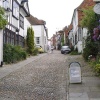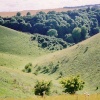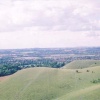Please login or click here to join.
Forgot Password? Click Here to reset pasword
 |  |  |  |  |  |
| Dave John Posts: 22335 Joined: 27th Feb 2011 Location: England | quotePosted at 16:05 on 8th March 2015 On 8th March 2015 11:20, Rod Burkey wrote:
Can't agree more re the filtering of tungsten lights, and of course they faded as they came close to their 'self destruct' date which didn't help either. In the end I had enough portrait and model agency work coming in I blew the bank and invested in a Bowens studio flash set up. Solved a lot of problems and made the sessions quicker too, or maybe not quicker as such but certainly more shooting time avaialble!! |
| Rod Burkey Posts: 554 Joined: 2nd Sep 2008 Location: UK | quotePosted at 23:24 on 8th March 2015 When I was using the blue filters,studio flash was very much a rarity. So, I generally opted for monochrome. But sometimes colour film was the only option. A studio session needed to be two hours to do what now takes half the time with multiple flash heads. Bliss! |
Robert E. Speicher Posts: 12 Joined: 17th Sep 2013 Location: USA | quotePosted at 13:21 on 13th March 2015 Hello all; I just "popped in" to read the responses to my question and I was brought to realize that I had not been more specific. When I was heavily into shooting landscape; using slide film, I would more often than not "see" where I had not caught the main point. As the years went by, I came to making the main point more obvious. I lived in the Hudson River valley in New York State and this area is great for landscape photography. Towns like "Cornwall" and "Cornwall on Husdson" were just two gold mines for geat photos. I used two lenses and eventually stayed with the 35-70 zoom. The 35 was, to me, better than a 28 mm. The 70-210 zoom was used to "shrink" some landscapes to bring out the main point. I only did this when I couldn't get closer. I remember reading an article about carrying a "slide" frame and using it as a frame on looking at "views." The idea was to get people to compose their photos. If I made some feel upset; I opologize. I wasn't being critical or trying to appear more learned. I really miss this hobby and I really enjoy the photos here. I hope some will take my original question and think about bringing the main point out in their photos so that others will see, too, what had caught the "takers" eye. |
| Rod Burkey Posts: 554 Joined: 2nd Sep 2008 Location: UK | quotePosted at 21:47 on 2nd April 2015 Yes it can. Robert, having reread this original post once again and then again, I struggled to come up with a clear cut answer about defining the subject of an image. The response could be that if the subject in a picture, regardless of the medium, is not clear in its intent, then it has simply failed. Sometimes the subject can be too familiar to the photographer and “sees what he / she means” but, it is lost on everyone else. The choice of lens, like a paint brush or chisel is of no relevance to the viewer. Today, I went over the Mersey, having checked my passport and found a good viewpoint just by the Seacombe ferry terminal, as I wanted to capture images of the ferry “Snowdrop” as she was facing the world for the first time in her new “Dazzle” livery. Clearly, she was the subject, but, to bring it all into context, I selected the backdrop of Liverpool, subject + context. The new livery is very eye-catching and the subject would have been diluted with a monochromatic rendering against a bland background. These images satisfy me, and score by being very clear in what is being portrayed. Yesterday, I took some pictures of the long suffering Mrs.Burkey. They were taken against the light from a window as she reclined after a light lunch. The subject was Wendy clearly, but also depicts her wistful mood. So, to me this is a strong image with a main subject and a subsidiary one. Can a picture have too much Robert? For me, yes it most certainly can, sending only confusion to the brain via the eyes. We all must see this in the work of others but hopefully delete ours when it happens. On location, the eye is often seduced by not only what you see, but also sometimes what you “want” to see. Before we press the shutter, a clear intention of what we want and really see is vital. Otherwise we fall into the trap of not only boring the pants off the viewer with too many pictures, but also presenting confusion with the subject matter, especially when that in itself is indefinable. So, Robert carry on looking at POE. Here you will find much to enjoy, and dare I say, also much to set off signals that might not please others. Such is life.
|
| Rod Burkey Posts: 554 Joined: 2nd Sep 2008 Location: UK | quotePosted at 23:36 on 2nd April 2015 John, our hobby is not a static thing hopefully. The joy us in how our styles change as time passes. Portrature is rather like capturing a landscape. Human features are a combination of shapes and texture, just like almost every thing we point our lenses at. What I attempt to do is capture things as I see them. Keeping a camera to hand makes a lot of sense. |
| Edward Lever Posts: 734 Joined: 22nd Dec 2005 Location: UK | quotePosted at 23:43 on 4th April 2015 On 2nd April 2015 21:47, Rod Burkey wrote:
|
| Dave John Posts: 22335 Joined: 27th Feb 2011 Location: England | quotePosted at 00:03 on 5th April 2015 On 4th April 2015 23:43, Edward Lever wrote: Spot on there boys, I usually have a look on the computer same day but then tend to leave them for a while and then look with a relatively fresh eye at a future date. Hence most of my submissions are sometimes weeks if not months after the taking date ... works for me...
|
| Please login to post to this thread... |